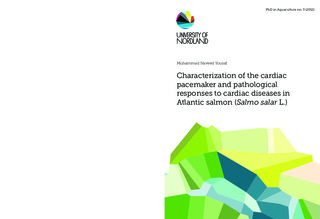Characterization of the cardiac pacemaker and pathological responses to cardiac diseases in Atlantic salmon (Salmo salar L.)
Doctoral thesis

Åpne
Permanent lenke
http://hdl.handle.net/11250/2367881Utgivelsesdato
2012Metadata
Vis full innførselSamlinger
Originalversjon
Yousaf, M. N. (2012). Characterization of the cardiac pacemaker and pathological responses to cardiac diseases in Atlantic salmon (Salmo salar L.) (Doctoral thesis). University of Nordland, Bodø.Sammendrag
The heart is considered the powerhouse of the cardiovascular system. In this thesis, characterization of cardiac pacemaker and potential biomarkers of cardiac diseases of Atlantic salmon (Salmo salar L.) were discussed. The normal performance of the heart requires balance, whether for coronary circulation, the synchrony and effectiveness of myocardial contractions or the influence of its nerves and ganglion cells. Neural control is equally important for the power and complexity of the heart. The pacemaker is the cardiac neural tissue that is responsible for initiation and control of heart beat.
This thesis described the location of cardiac pacemaker of Atlantic salmon at the junction of sinus venosus and atrium. Morphologically, the pacemaker tissue was composed of lightly stained plexiform modified cardiomyocytes, wavy appearing nerve bundles with oval, wavy, elongated nuclei with pointed ends and large round to pear–shaped postganglionic nerve cell bodies (ganglion cells). Novel immuno–localization of the natriuretic peptides such as salmon cardiac peptide (sCP) and ventricular natriuretic peptide (VNP) in the postganglionic nerve cell bodies at SA junction was demonstrated, suggesting their neuromodulatory/neurotransmitter roles in teleosts (Atlantic salmon). Besides CD3 as a general T cell marker, novel CD3 immunostaining in the postganglionic nerve cell bodies of cardiac pacemaker of Atlantic salmon was demonstrated, suggesting additional roles of CD3 in teleosts and shared similar patterns to mammals. Atlantic salmon aquaculture industry bears huge losses due to viral diseases including cardiac viral diseases. Heart and skeletal muscle inflammation (HSMI), cardiomyopathy syndrome (CMS) and pancreas disease (PD) are viral diseases of marine farmed Atlantic salmon which mainly affect the heart in addition to other vital organs. The main findings of these diseases are necrosis and mononuclear inflammatory cells infiltrates affecting different regions of the heart. To identify the potential biomarkers of cardiac diseases, blood biochemistry markers were correlated to the CMS– and HSMI–affected Atlantic salmon. Candidate biomarkers included serum enzymes such as creatine kinase (CK) and lactate dehydrogenase (LDH) levels were measured and significantly correlated to the cardiac pathology of HSMI–affected fish, suggesting promising potential biomarkers to predict the disease (HSMI). Non–significant correlations of serum enzymes to CMS–affected fish suggested that serum enzymes could be used to differentiate between the HSMI and CMS. Further, immunohistochemistry was performed to identify potential markers of cardiac pathological changes of Atlantic salmon affected with similar cardiac diseases (CMS, HSMI and PD). The spectrum of inflammatory cells associated with the cardiac pathology consisted of mainly CD3Ɛ+ T lymphocytes and lymphocytic response dominated over granulocytes in the CMS–, PD– and HSMI–affected hearts. Macrophage–like and eosinophilic granular cells were identified by rTNFα antiserum in all three investigated diseased hearts, particularly in areas surrounding lesions. MHC class II antiserum identified strong, moderate and low levels of immunopositive cells in diseased hearts in HSMI, CMS and PD respectively. The CD3, MHC class II, PCNA, TNFα, caspase 3 and TUNEL staining were mostly confined to lesioned areas in the diseased hearts, pointing to pathological changes and suggesting the markers appear promising as a supplementary tool in the identification of lesioned areas in the investigated diseased hearts. Interestingly, the apparently similar diseases exhibited differences in the immunopathological responses in Atlantic salmon.
Beskrivelse
Doctoral thesis (PhD) – University of Nordland, 2012
Består av
Paper I: Yousaf, M. N., Amin, A., Koppang, E. O., Vuolteenaho, O. and Powell, M. D. (2012). Localization of natriuretic peptides in the cardiac pacemaker of Atlantic salmon (Salmo salar L.). Acta Histochemica, 114(8), 819-826. doi: 10.1016/j.acthis.2012.02.002. Full text is not available in Brage Nord.Paper II: Yousaf, M. and Powell, M. D. (2012). The effects of heart and skeletal muscle inflammation and cardiomyopathy syndrome on creatine kinase and lactate dehydrogenase levels in atlantic salmon (Salmo salar L.). Scientific World Journal, 2012. doi: 10.1100/2012/741302. The article is available at: http://hdl.handle.net/11250/286431
Paper III: Yousaf, M. N., Koppang, E. O., Skjødt, K., Köllner, B., Hordvik, I., Zou, J., . . . Powell, M. D. (2012). Cardiac pathological changes of Atlantic salmon (Salmo salar L.) affected with heart and skeletal muscle inflammation (HSMI). Fish and Shellfish Immunology, 33(2), 305-315. doi: 10.1016/j.fsi.2012.05.008. Full text is not available in Brage Nord.
Paper IV: Yousaf, M. N., Koppang, E. O., Skjødt, K., Hordvik, I., Zou, J., Secombes, C. and Powell, M. D. (2012). Comparative cardiac pathological changes of Atlantic salmon (Salmo salar L.) affected with heart and skeletal muscle inflammation (HSMI), cardiomyopathy syndrome (CMS) and pancreas disease (PD). Veterinary Immunology and Immunopathology, 151(1-2), 49-62. doi: 10.1016/j.vetimm.2012.10.004. Author's accepted version (postprint) is available at: http://hdl.handle.net/11250/2367850